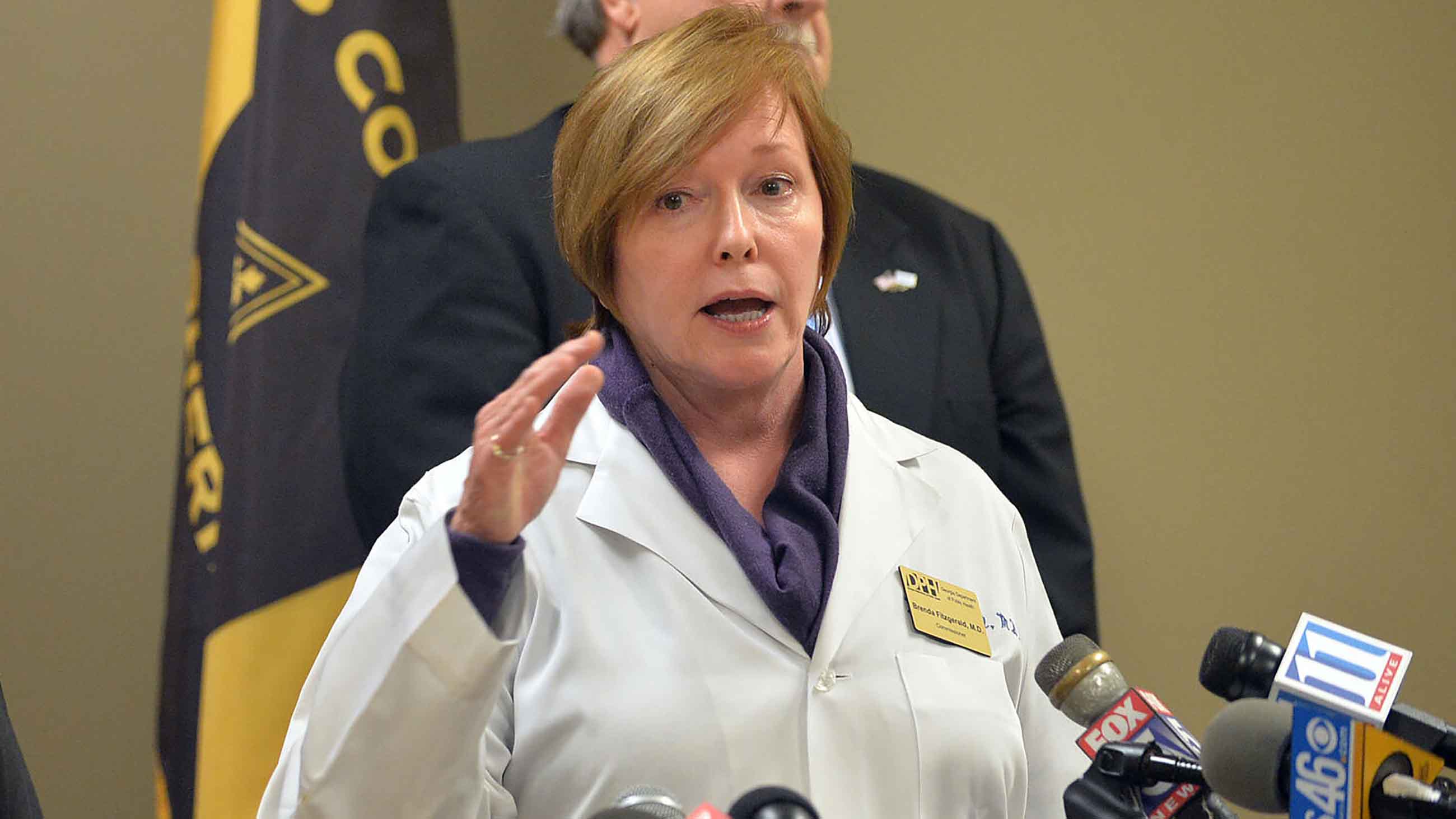Trump’s Incoming CDC Chief Brings a Mixed Record on Public Health
An Undark review of health statistics collected during her tenure as Georgia’s public health commissioner reveals a decidedly lackluster record for Dr. Brenda Fitzgerald, the Trump administration’s recent pick to head up the federal Centers for Disease Control and Prevention.
Fitzgerald held the state-level position for six years — from 2011 until her appointment this month to the Atlanta-based CDC by Tom Price, President Trump’s Secretary of Health and Human Services. Like Price, Fitzgerald is a medical doctor who has worked for decades in Georgia, and her appointment has been welcomed in some circles, even winning praise from former CDC chief Tom Frieden.
Critics, meanwhile, have pointed to Fitzgerald’s odd association with unscientific anti-aging medications, and dubious partnerships with the sugary drink giant Coca-Cola in state-level anti-obesity campaigns.
An examination of actual health outcomes in Georgia before and after Fitzgerald’s arrival at the Department of Public Health offers a similarly mixed bag of results. During Fitzgerald’s tenure as Georgia’s commissioner of public health, for example, the state clearly improved on some measures, including immunization coverage for teenagers. But in a combined-outcomes assessment calculated annually for each state, Georgia’s ranking dropped from 37th place in 2011 to 41st 2016.
Of course, Georgia has long lagged behind other U.S. states on the majority of more than two dozen standard measures of public health collected and analyzed annually for the America’s Health Rankings report, a long-running state-by-state review of America’s public health status. The report, published each year since 1990, is produced through a partnership between the UnitedHealth Foundation, part of the Minnesota-based insurance company, UnitedHealth Group, and the American Public Health Association in Washington, D.C.
In producing the rankings, staffers at the foundation and at Arundel Metrics, a Minnesota-based data analytics consultancy, compile data obtained from several U.S. agencies, as well as the World Health Organization, the American Medical Association, and Trust for America’s Health, among others. The foundation releases its annual America’s Health Rankings report near the end of every year, and it includes an analysis of the nation’s overall health status, as well as the performance of each U.S. state on health measures ranging from the rates of adult smoking to premature deaths.
At Georgia’s Department of Public Health, one of Fitzgerald’s biggest challenges was shepherding the state’s response to an outbreak of Ebola that started in 2014. She is also known for her work on behalf of Georgia Shape, a program to reduce childhood obesity. However, the organization received $1 million in funding from Coca-Cola and emphasized physical activity while neglecting to mention reducing soda and sugar consumption.
Separately, she reportedly led efforts to improve childhood immunization rates, advocated for maternal and child health, reduced wait times for medications for HIV, and led efforts to discourage smoking.
A closer look at the Health Rankings report suggests that Georgia made progress on curbing obesity and improving other public health outcomes during Fitzgerald’s tenure as commissioner. The state’s national ranking on the prevalence of obesity went from 38th in 2011 to 31st in 2016. For immunizations among toddlers, Georgia went from 14th place to 11th place. For immunizations among adolescents, the state went from 29th place to 21st place, though the teen data were collected only from 2013 to 2016. The state’s ranking on cardiovascular deaths improved from 40th place in 2011 to 36th in 2016.
At the same time, the state’s ranking for smoking prevalence ended up in 2016 exactly where it started in 2011 — 27th in the nation. And the state’s ranking for percent of physically inactive adults or adults with a sedentary lifestyle dropped from 31st place in 2012 to 36th in 2016.
During a lecture she gave in 2014, Fitzgerald named other public health issues that were at the forefront of her mind. She said several health stats “keep me up at night,” including the 2013 America’s Health Rankings for Georgia on percent of children in poverty, infant mortality, years lost to premature deaths, percent of people who lack of health insurance, and high school graduation rate.
Within the America’s Health Rankings, the state’s placement for percentage of high-school graduations improved from 46th place in 2011 to 40th in 2016, but Georgia’s rankings worsened for the percentage of children living in poverty (from 40th to 49th place). For infant mortality, years lost to premature deaths, and percentage of people without health insurance, Georgia ended up in 2016 exactly or almost exactly where they started — closer to the bottom of the rankings than to the top.
The CDC did not respond to a request for a comment from Fitzgerald or the agency, but J. Patrick O’Neal, now the interim commissioner of the Georgia Department of Public Health, did.
“Because of the tremendous leadership and vision of my friend and colleague Brenda Fitzgerald, the department is well-positioned to move forward in addressing the important health matters that affect the lives of Georgians,” O’Neal wrote in an email on Wednesday to Undark. “The progress we’ve made in Georgia around early brain development, childhood obesity and creating a model for addressing the Ebola epidemic would not have been possible without the determination and persistence of Dr. Fitzgerald.”
In fact, no one person can turn around the public health of a state or nation, says Robert Lustig, a professor of pediatrics at the University of California, San Francisco. “I wouldn’t necessarily say that the fact that Georgia has done worse under Brenda Fitzgerald as commissioner is necessarily a black mark against her,” he says.
It’s true that relative state rankings on public health only provide a partial view into an administrator’s performance, particularly in the face of growing populations and anti-tax sentiments. Tropical weather conducive to infectious disease outbreaks can also put southern regions at a disadvantage. And relative rankings can mask absolute progress, as well as fail to reflect the effort required just to keep a region’s health from worsening.
At the same time — and setting aside Fitzgerald’s embrace of bogus anti-aging science — critics suggest that Americans might have hoped for a stronger track record for the nation’s incoming top public health official. Many other people in the field of public health might have been better candidates for the job of CDC chief, Lustig said — particularly given her very limited research record and her past relationship with Atlanta-based Coca-Cola.
“The question is, ‘Is that a disqualifier for her being CDC director?’” Lustig asked. “In my view, the answer to that is absolutely, emphatically, yes.”
Robin Lloyd is the former news editor for Scientific American, and she writes frequently for Undark’s Cross Sections blog.











Comments are automatically closed one year after article publication. Archived comments are below.
Reduce opioid use dramaticly, stop the pharma money train, legalize cannabais for medical pain reduction only (none to very limited liver damage, no direct brain damage, healthlier alternative to Pharma medications.)
This war on “opioids” is actually a war on chronic incurable diseases. A war on chronic pain disease patients who benefit from opioid medications. Medications that enable millions of Americans relief of chronic debilitating pain associated with these diseases.
The fiction, widespread hysteria and distorted truths about this “opioid epidemic”, is killing legitimate chronic pain disease patients who use their medications responsibly. We are patients.
100 million Americans have one or more chronic incurable pain Diseases. As the CDC, DEA, FDA, Medicaid and Medicare, and numerous other government agencies, are blaming Doctors for the over prescribing of opioid medication. NOBODY, is looking at or reading the statistics from chronic pain disease patients. How about NOT addressing these drugs as dangerous and addictive. When all else fails: physical therapy, exercise, over the counter medications and numerous injections etc, we chronic pain disease patients, are left with one option to help us cope, opioid pain medication. Lets address this medication as lifesaving and medically necessary for the million of Americans with chronic diseases. Chronic pain is a disease. Chronic pain disease patients are now the epidemic. The addiction rate of chronic pain disease patients is .02-.6 %. We do not misuse or abuse our medications.
No other disease medication is scrutinized. We, as patients, are being denied, dismissed, overlooked and discriminated against, by our physicians, due to all the scrutiny associated with treating chronic pain disease with opioid medications. Our Dr’s are afraid to treat us humanely and adequately. We have a disease that medication is readily accessible and beneficial to us and we are being denied. We, pain patients, are being discriminated against, due to people who abuse illegal heroin and illegal fentanyl. This is a direct hunt for Doctors who prescribe life saving medication, for pain disease patients, that benefit from them. We have our privacy invaded, we no longer are able to have doctor/patient confidentiality. We now have insurance agencies, pharmacists, and other government agencies in our physicians offices, monitoring, prosecuting and policing our physicians.
Though the statistics show a reduction in, opioid medications distributed, due to the CDC guidelines, death rates of overdoses from illegal opioids is rising.
The specific causes of deaths also needs to be closely investigated. The opioid in the person’s system needs to be specified. Was it an illegal opioid, was it opioid medication specifically for that person, was there other drugs or alcohol involved? These statistics need to come out. These Government agencies do not want that information out, due to the fact that this “opioid epidemic”, would then be debunked.
Let’s put the shoe on the other foot. Restricting or taking away our medications is like FORCING people who do not want this medication to take it. One day those against these medications will need them but they will be denied.
We have a chronic disease. We want to be able to take care of our homes, our children, our selves, as much as possible. Without access to these life saving medications, we are unable to do so. We want to live, not just exist in pain 24/7.
We need the government agencies to look at the real statistics, not the hand picked. These agencies are not physicians. They are trying to doctor us, patients, without a medical license. They are also trying to police our physicians. This is a war on a disease, medications, physicians and patients.
We, chronic pain disease patients, need help. All the headlines, topics and stories on how opioids are bad and how people are abusing, misusing, overdosing, becoming addicted or dying from them. We need to look at the good they do and how they help our disease of chronic pain and the million of Americans who use them for some relief.
The government needs to put the focus on illegal drugs coming into, being manufactured and distributed in this country, illegal fentanyl, illegal heroin, methamphetamine, cocaine and all other ILLEGAL DRUGS. Not the legally prescribed and medically necessary medications we patients need. We chronic pain disease patients need help, but we are helpless due to the government and government agencies. There is stigma, scrutiny and discrimination against us due to a category of medications we desperately need and benefit from, opioid medications.
WE ARE PATIENTS NOT ADDICTS! !